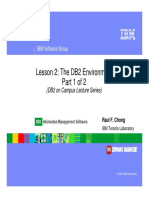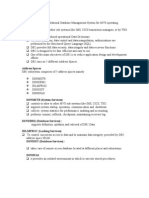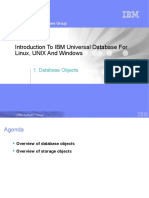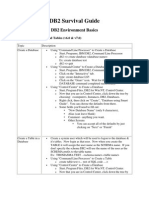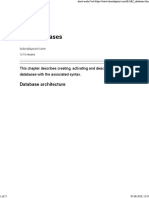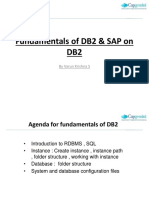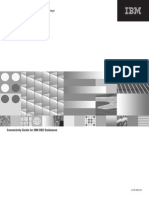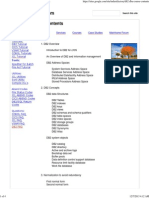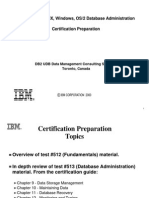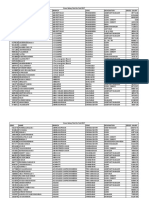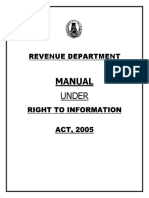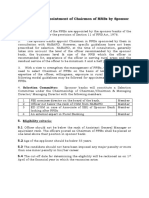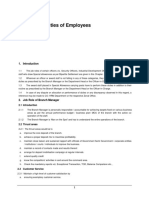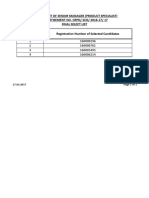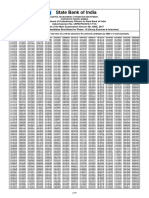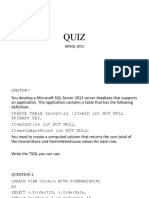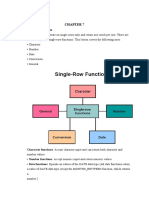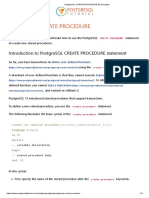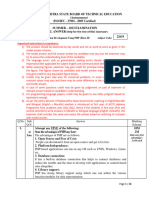Information Management Ecosystem Partnerships
IBM Canada Lab
Summer/Fall 2010
Working with Databases and Database
Objects in DB2
Information Management
2010 IBM Corporation
�Information Management
Agenda
Servers, Instances, and Databases
Managing Instances
Creating a DB2 Database
Cataloging
Database (Data) Objects
2010 IBM Corporation
�Information Management
2010 IBM Corporation
�Information Management
Servers, Instances, and Databases
DB2 views the world as a hierarchy of objects
Server
..upon installation, the DB2 Database Manager
(program files) are copied to the server, and an
instance of the DB2 Database Manager is created.
..instances are responsible for managing system
resources and databases that fall under their control.
..databases are responsible for managing the
storage, modification, and retrieval of data.
INSTANCE is a logical database server
environment.
Instance
Database
1
Database
2
2010 IBM Corporation
�IB M D B 2 9
Information Management
M o re o n in s ta n c e s
T h e d e fa u lt in s t a n c e f o r a p a r t ic u la r s y s t e m is d e f in e d b y th e
D B 2 IN S T A N C E e n v ir o n m e n t v a r ia b le . I n itia lly f o r W in d o w s
d e f a u lt is D B 2 a n d f o r L in u x / U n ix it is d b 2 in s t 1 .
D B 2 9 In s ta n c e M a n a g e m e n t C o m m a n d s :
4
5
C om m and
P u rp o s e
d b 2 ic r t [In s ta n c e N a m e ]
C re a te s a n e w in s ta n c e
d b 2 id r o p [In s ta n c e N a m e ]
D e le te s ( d r o p s ) a n e x is tin g in s ta n c e
d b 2 ilis t
L is ts a ll in s ta n c e s th a t h a v e b e e n d e fin e d
d b 2 s ta rt
S ta rts th e D B 2 D a ta b a s e M a n a g e r b a c k g ro u n d
p r o c e s s e s f o r th e c u rr e n t in s ta n c e
d b 2 s to p
S to p s th e D B 2 D a ta b a s e M a n a g e r b a c k g ro u n d
p r o c e s s e s f o r th e c u rr e n t in s ta n c e
2010 IBM Corporation
�Information Management
Instances
Stand-alone DB2 environment
Can have multiple instances per data
server
All instances share the same executable
binary files
Each instance has its own configuration
Different software level for an instance
Command
Description
Example
db2start
Start the default instance
db2start
db2stop
Stop the current instance
db2stop -f
db2icrt
Create an instance
db2icrt u db2fenc1 db2inst1
db2idrop
Drop an instance
db2idrop f db2inst1
db2ilist
List all instances
db2ilist
db2imigr
Migrate an instance after upgrading DB2
db2imigr u db2fenc1 db2inst1
db2iupdt
Update an instance after installation of a fix pack
db2iupdt u db2fenc1 db2inst1
2010 IBM Corporation
�Information Management
DB and DBM configurations
Description
Example
View Database Manager Settings
db2 get dbm cfg show detail
Change a Database Manager Setting
db2 update dbm cfg using <parameter> <value>
Description
Example
View Database Settings
db2 get db cfg for <database>
db2 connect to <database>
db2 get db cfg show detail
Change a DB Setting
Change value of logretain &
userexit db config parameters
db2 update db cfg using logprimary 10
Retrieving original value (on disk)
and updated value (in memory)
Querying the resulting global
Temporary table (DB_CONFIG)
UPDATE DB CFG USING LOGRETAIN RECOVERY USEREXIT ON
CALL SYSPROC.GET_DB_CONFIG()
SELECT DBCONFIG_TYPE, LOGRETAIN, USEREXIT FROM SESSION.DB_CONFIG
Result:
2010 IBM Corporation
�Information Management
Database Storage Model
2010 IBM Corporation
�Information Management
DB2 Storage Model
LOGICAL STORAGE MODEL
TABLES are made up of COLUMNS and ROWS
TABLES are placed into table spaces
TABLE SPACE can have more then one table
PHYSICAL STORAGE MODEL
CONTAINER is a physical storage device
Can be a device , directory or a file
Container is assigned to table space
2010 IBM Corporation
�Information Management
TABLE SPACES
TABLE SPACES is a logical space between data and storage
devices.
Consists of more then one containers.
Tables, regular data, indexes, and long data resides in table
spaces.
SQL: CREATE / ALTER / DROP TABLESPACES
To display tablespaces info:
LIST TABLESPACES [ SHOW DETAIL]
Details about containers can be obtained with a following
command.
LIST TABLESPACE CONTAINERS for tablespace_id
[SHOW DETAIL]
10
2010 IBM Corporation
�Information Management
DB2 Storage:: Table Spaces Overview
11
Logical objects in between logical
table and physical containers
Allows assignment of the location
of data to particular logical devices
or portions thereof
All tables, indexes, and other data
are stored in a table space
Can be associated to a specific
buffer pool
Containers can be files,
directories or raw devices
2010 IBM Corporation
�Information Management
TABLESPACE STORAGE MANAGEMENT
System Managed Space (SMS):
OS's FILE SYSTEM MANAGER allocates and manages the
space.
Database Managed Space (DMS):
Here, the Database manager controls the storage space.
12
Automatic Storage with DMS:
Databases are enabled for automatic storage have a set of
one or more storage paths associated with them.
A table space can be defined as managed by automatic
storage and its containers assigned and allocated by DB2
based on those storage paths.
You cannot enable/disable storage once it has been defined
for database.
Default type in DB2 9
2010 IBM Corporation
�Information Management
DB2 Storage:: Table Space Management
System Managed Spaces (SMS)
Data stored in files representing data objects
Space is allocated on demand
Access to data controlled using standard I/O functions of the OS
Ideal for small, personal databases and databases that grow/shrink rapidly
Low maintenance and monitoring
CREATE TABLESPACE tbsp1 MANAGED BY SYSTEM
USING ('d:\acc_tbsp', 'e:\acc_tbsp', 'f:\acc_tbsp')
Database Managed Spaces (DMS)
Data stored in files or on raw devices
Storage space pre-allocated in file system, typically contiguous
physically
Ideal for performance-sensitive applications
Increased maintenance and monitoring
CREATE TABLESPACE tbsp2
PAGESIZE 8K MANAGED BY DATABASE
USING (FILE ' /storage/dms1' 10 M) AUTORESIZE YES
13
2010 IBM Corporation
�Information Management
DB2 Storage:: Table Space Management
Automatic Storage Table Space
DBM creates and extends containers as needed up the
limits imposed by the storage paths associated with the
database
Automatically handles resizing table spaces
Creates a DMS table space for regular/large table spaces
Creates a SMS table space for user or system temporary
table spaces
New DB & TBSP
are handled by automatic storage
by DEFAULT
CREATE DATABASE mydb AUTOMATIC STORAGE YES
CONNECT TO mydb
CREATE TABLESPACE tbsp1 MANAGED BY AUTOMATIC STORAGE
14
2010 IBM Corporation
�Information Management
DB2 Storage:: Buffer Pools
Area of main memory used to cache table
and index data
Each database must have at least one
buffer pool
By default IBMDEFAULTBP is used
Buffer pools can be created, dropped or altered
SYSCAT.BUFFERPOOLS catalog view
accesses the information for the buffer pools
defined in the database
Every table space associates a specific
buffer pool of the same page size
Match buffer pool size with purpose of table
to increase hit ratio
Self-Tuning Memory Manager (STMM)
available
CREATE BUFFERPOOL bp4k PAGESIZE 4K
CREATE TABLESPACE tbsp1 PAGESIZE 4K BUFFERPOOL bp4k
15
2010 IBM Corporation
�Information Management
Databases
What makes up a DB2 database?
A DB2 database is made up of a collection of objects
A database contains the following objects:
Tables, views, indexes, schemas
Locks, triggers, stored procedures, packages
Buffer pools, log files, table spaces
Which tools can help you create DB2 databases?
First Steps
Control Center (GUI wizard)
Command Line Processor (CLP)
16
2010 IBM Corporation
�Information Management
Creating a DB2 Database First Steps
17
As part of the DB2
installation process, the
First Steps panel is
displayed allowing the
user to generate a
number of a sample
databases to work with
To launch the first steps
interface issue db2fs
from a DB2 command
line
2010 IBM Corporation
�Information Management
Typical Directory Hierarchy Tree
Location specified when the database was created OR the
value of the dftdbpath DBM configuration parameter.
DATABASE_PATH
INSTANCE_NAME
Directory with the name of the instance that controls the database.
Directory with the name of the node number assigned to this
partition (always NODE0000 if database is nonpartitioned).
Directory with the name that was assigned to the
DATABASE_NAME
database.
NODExxxx
T0000000
T0000001
C0000000.TMP
Directories containing file or sub-directory
containers for the SYSCATSPACE, TEMPSPACE1,
and USERSPACE1 table spaces.
T0000002
Database directory (name matches the database
token assigned to the database).
SQL0000x
DB2EVENT
Directory for event monitor data.
SQLOGDIR
Directory for transaction log files.
Files needed for database recovery and
bookkeeping tasks,
18
2010 IBM Corporation
�Information Management
Creating a DB2 Database Command Line
The CREATE DATABASE command initializes a new database
>>-CREATE--+-DATABASE-+--database-name----------------------->...
Examples:
CREATE DATABASE TESTDB1
database-name
CREATE DATABASE TESTDB2 ON C:
CREATE DATABASE TESTDB3
AUTOMATIC STORAGE YES
ON C:,D: DBPATH ON E:
Database is
created on drive C:
Database is
created on drive E:
Automatic store is enabled and
storage paths are C: and D:
19
2010 IBM Corporation
�Information Management
With Database, DB2 automatically creates
20
The three table spaces are created:
SYSCATSPACE: This is where DB2 system catalog is kept
that tracks all of the metadata associated with DB2 objects.
TEMPSPACE1- A temporary work area where DB2 can
place intermediate results.
USERSPACE1- a place where all user objects (tables,
indexes) resides by default.
Configuration information (DB CFG)
Log files, History files etc
2010 IBM Corporation
�Information Management
With databases, DB2 automatically creates...
System temporary
table space
TEMPSPACE1
(1 required)
System temporary space
Work area for operations,
for example: join, sorts
Catalog table spaces
SYSCATSPACE
(1 required)
Configuration
Information (DB CFG)
Log Files
Catalog tables with metadata
History Files
Must exist
Etc.
User Table Spaces
USERSPACE1
(1 or more required)
21
Default user table space
Can be deleted
All user defined tables
2010 IBM Corporation
�Information Management
DB2 Data Server Clients
IBM Data Server Runtime Client
JDBC, ADO.NET, OLE DB, ODBC, CLI, PHP, and
Ruby
IBM Data Server Drivers
Light weight deployment solution for ISVs
Must be installed manually
Has CLP but GUI tools are not included
Support LDAP exploitation, TCP/IP and Named
Pipe, cataloging
IBM Data Server Client
All the functionality of IBM Data Server Runtime
Client
22
Plus functionality for database administration,
application development, and client/server
configuration.
IBM Data Server Driver for JDBC and SQLJ
Java stored procedures and userdefined functions
JDBC, SQLJ
IBM Data Server Driver for ODBC and CLI
ODBC API, or CLI API
IBM Data Server Driver Package
ODBC, CLI, .NET, OLE DB, PHP,
Ruby, JDBC, or SQLJ
Capabilities include GUI tools such as
configuration assistant, control center, visual
studio tools
2010 IBM Corporation
�Information Management
Cataloging
DB2 has multiple directories that are used to access
databases
The system database directory contains a list and
pointer to where all the known databases can be found.
(list db directory)
The node directory contains information relating to how
and where remote systems or instances can be found.
( list node directory)
The Database Connection Services (DCS) Directory
contains information relating to how and where
databases on DRDA systems can be found.
( list dcs directory)
23
2010 IBM Corporation
�Information Management
Ways of Cataloging a Database at a Client
Automated configuration using discovery
Search discovery client searches server on the network
Known discovery one particular server is queried for
information
Automated configuration using access profiles
Server profiles contains information on instances and
databases
Client profiles used to duplicate information from one client to
another
Manual configuration
Configuration Assistant (graphical)
Data Studio (graphical)
Command Line Processor (CLP)
24
2010 IBM Corporation
�Information Management
Cataloguing:: Setting Up Communications
To use a remote database:
1. Catalog the remote system (node)
2. Catalog the database within the remote node
3 tools available:
Configuration Assistant (graphical)
Data Studio (graphical)
Command Line Processor (CLP)
alias
db2 list [database|node]
directory
can be used to find the locally
catalogued DB or node
host_name or ip_addr
catalog tcpip node db2_node remote mysystem server
db2tcp42
service_name
or port_number
database_name
database_alias
node_name
catalog database sample as mysample at node db2node
authentication server
25
authentication_type
2010 IBM Corporation
�Information Management
Database (Data) Objects
Database objects, also known as data objects, are used to
control how all user data (and some system data) is stored
and organized within a DB2 database
Tables
Schemas
Indexes
Aliases
User-Defined
Functions
26
Views
Sequences
Stored
Procedures
Triggers
Packages
2010 IBM Corporation
�Information Management
Database Object : SCHEMA
27
2010 IBM Corporation
�Information Management
Schemas
Schemas (unique identifiers) are objects that are used to
logically classify and group other objects in the database.
Schemas have privileges associated with them that allow the
schema owner to control which users can create, alter, and
drop objects within them.
Benefits of a schema:
Tedious to search through entire database for objects with the
same name
The name of each object needs to be unique only within its schema
Access control
When an object is created without specifying a schema, object will
be associated with an implicit schema using the authorization ID.
28
2010 IBM Corporation
�Information Management
Schemas
Most database objects have a two-part object name
The first part being the schema name (or qualifier)
The second is the object name
When an object is created, you can assign it to a specific schema
SCHEMA_NAME.OBJECT_NAME
For example
CREATE SCHEMA PAYROLL
CREATE TABLE PAYROLL.STAFF
Table named STAFF is
assigned to the PAYROLL schema
29
2010 IBM Corporation
�Information Management
Schemas Example :: Using the command line
CREATE SCHEMA payroll AUTHORIZATION user1;
Schema
name
Creates a schema for an
individual user with the
authorization ID "USER1"
COMMENT ON SCHEMA payroll IS 'schema for payroll
application';
Schema to
comment on
30
Comment
string
2010 IBM Corporation
�Information Management
Tables
A relational database presents data as a collection of tables
A table consists of data logically arranged in columns and
rows (records)
each column contains values of the same data type
each row contains a set of values for each column available
Value
The storage representation
of a row is called a record Record
(Row)
31
the storage representation
of a column is called a field
each intersection of a row
and column is called a value
DEPARTMENT Table
DEPTID
DEPTNAME
COSTCENTER
A000
ADMINISTRATION
10250
B001
PLANNING
10820
C001
ACCOUNTING
20450
D001
HUMAN RESOURCES 30200
E001
R&D
50120
E002
MANUGACTURING
50220
E003
OPERATIONS
50230
Field
(Column
)
2010 IBM Corporation
�Information Management
Tables 3 Main Types of Tables
Base Tables
Userdefined tables designed to hold persistent user data
CREATE TABLE department
column-name:
(deptid
CHAR(4),
names a column of
deptname
VARCHAR(30),
the table
costcenter INTEGER);
table-name
data-type
Result Tables
DB2 Database Managerdefined tables populated with rows retrieved
from one or more base tables in response to a query
Declared Temporary Tables
Userdefined tables used to hold nonpersistent data temporarily, on behalf
of a single application.
Explicitly created by an application when they are needed and implicitly
destroyed when the application that created them terminates its last
database connection.
Created with DECLARE GLOBAL TEMPORARY TABLE statement
32
2010 IBM Corporation
�Information Management
Views
Views can be seen as virtual tables derived from one or more
tables or views
Created to limit access to sensitive data or group together data
from different tables in a single object.
Views do not contain real data.
Only the view definition itself is actually stored in the database
Can be deletable, updatable, insertable, and read-only.
When changes are made to data through a view, the data is
changed in underlying table itself.
Can be used interchangeably with tables when retrieving data.
33
CREATE VIEW dept_view AS SELECT * FROM department
2010 IBM Corporation
�Information Management
Views Example :: Simple view referencing two base tables
view-name
Defines the
view
T1
CREATE VIEW myview(empid, name, instname) AS
SELECT T1.empid, T1.name, T2.name
Identifies the view
FROM T1, T2
definition
WHERE T1.instid=T2.instid
EMPID
T2
NAME
INSTID
INSTID
NAME
001
JAGGER, MICK
H01
H01
HARMONICA
002
RICHARDS, KEITH
G01
G01
GUITAR
003
WOOD, RONNIE
G01
D01
DRUMS
004
WATTS, CHARLIE
D01
B01
BASS GUITAR
005
WYMAN, BILL
B01
K01
KEYBOARD
006
JONES, BRIAN
G01
S01
SAXAPHONE
myview
34
column-name(s)
EMPID
NAME
INSTNAME
001
JAGGER, MICK
002
RICHARDS, KEITH GUITAR
003
WOOD, RONNIE
GUITAR
004
WATTS, CHARLIE
DRUMS
005
WYMAN, BILL
BASS GUITAR
006
JONES, BRIAN
GUITAR
HARMONICA
2010 IBM Corporation
�Information Management
Indexes
An index is an object that contains an ordered set of pointers
that refer to rows in a base table. They are based upon one
or more columns but stored as a separate entity.
DEPARTMENT Table
DEPTID
DEPTID Index
35
DEPTID
ROW
A000
B001
C001
D001
11
E001
E002
E003
F001
F002
F003
G010
10
Row 1
Row 2
Row 3
Row 4
Row 5
Row 6
Row 7
Row 8
Row 9
Row 10
Row 11
DEPTNAME
COSTCENTER
F001
ADMINISTRATION
10250
B001
PLANNING
10820
E001
ACCOUNTING
20450
E003
HUMAN RESOURCES
30200
A000
R&D
50120
E002
MANUGACTURING
50220
F003
OPERATIONS
50230
C001
MARKETING
42100
F002
SALES
42200
G010
CUSTOMER SUPPORT 42300
D001
LEGAL
60680
2010 IBM Corporation
�Information Management
Indexes Importance
..provide a fast, efficient method for locating specific rows of
data in very large tables.
..provide a logical ordering of the rows of a table
36
..can be used to enforce the uniqueness of records stored in
a table.
..can force a table to use clustering storage, which causes
the rows of a table to be physically arranged according to the
ordering of their index column values.
CREATE UNIQUE INDEX empno_indx ON
employees(empno)
2010 IBM Corporation
�Information Management
Indexes Example
Suppose you had the following EMPLOYEES base table..
Column
Name ...
Data Type ...
EMPNO
INTEGER
FNAME
CHAR(20)
LNAME
CHAR(30)
TITLE
CHAR(10)
DEPARTMENT
CHAR(20)
SALARY
DECIMAL(6,2)
..and you wanted to create an index such that the index key
consists of the column named EMPNO and all employee numbers
entered will be guaranteed to be unique..
37
2010 IBM Corporation
�Information Management
Indexes Example (continued)
UNIQUE prevents the table from
containing two or more rows with the
same value of the index key
CREATE UNIQUE INDEX empno_indx
ON employees(empno)
table-name identifies a table on
which an index is to be created
38
column-name identifies a column
that is to be part of the index key
2010 IBM Corporation
�Information Management
Example of INDEX
CREATE TABLE parts ( part_no INT (9) NOT NULL,
part_name VARCHAR(24), pert_remain INT (9))
Creating an INDEX on column part_no
CREATE UNIQUE INDEX idx_partno ON parts(part_no)
39
2010 IBM Corporation
�Information Management
Aliases
An alias is an alternate name for an object such as a table or
view.
Like other objects, an alias can be created, dropped, and have
comments associated with it.
Aliases are publicly referenced names, so no special authority or
privilege is required to use them.
However, access to the table or view that an alias refers to still
requires appropriate authorization.
40
Aliases can be created by executing the CREATE ALIAS SQL
statement
2010 IBM Corporation
�Information Management
Aliases
Example
..you wanted to create an alias that references a table named
EMPLOYEES and you wanted to assign it the name EMPINFO..
CREATE ALIAS empinfo FOR employees
Names the alias. The name must not
identify a table, view, nickname, or alias
that exists in the current database.
Identifies the table,
view, nickname, or
alias for which aliasname is defined.
Why use an alias instead of the actual object name?
So that SQL statements can be constructed such that they are
independent of the qualified names that identify the base tables or
views they reference.
41
2010 IBM Corporation
�Information Management
SEQUENCE
Sequence is an object that used to generate data values
automatically.
Default increment value is 1
PREVIOUS VALUE expression returns the most recent generated
generated value for sequence.
NEXT VALUE expression returns the next sequence value.
MAXVALUE of a sequence can be equal to MINVALUE.
42
CREATE SEQUENCE emp_id START WITH 100 INCREMENT BY 10
CACHE 5
2010 IBM Corporation
�Information Management
Sequences
A sequence is an object that is used to generate data values
automatically. Unlike an identity column, a sequence is not
tied to any specific column or any specific table.
An identity column provides a way for DB2 to automatically
generate a unique numeric value for each row that is added to the
table.
Sequences have the following characteristics:
Values generated can be any exact numeric data type that has a
scale of zero (SMALLINT, BIGINT, INTEGER, or DECIMAL).
Consecutive values can differ by any specified increment value.
Counter values are recoverable. Counter values are reconstructed
from logs when recovery is required.
Values generated can be cached to improve performance.
43
2010 IBM Corporation
�Information Management
Sequences
Sequences can generate values in one of three ways:
By incrementing or decrementing by a specified amount, without
bounds
By incrementing or decrementing by a specified amount to a
userdefined limit and stopping
By incrementing or decrementing by a specified amount to a
userdefined limit, and then cycling back to the beginning and
starting again
Example: if you wanted to create a sequence that generates
numbers, starting with the number 100 and incrementing
each subsequent number produced by 10
CREATE SEQUENCE emp_id START WITH 100 INCREMENT BY 10
Names the sequence
Specifies the first
value for the sequence
44
Specifies the interval
between consecutive
values of the sequence
2010 IBM Corporation
�Information Management
Example of SEQUENCE
CREATE SEQUENCE my_seq START WITH 5 INCREMENT BY 5 CACHE 5
User1 successfully executes the following statements in Connection1:
VALUES NEXT VALUE FOR my_seq INTO :con1hvar
VALUES NEXT VALUE FOR my_seq INTO :con1hvar
User2 successfully executes the following statement in Connection2:
VALUES NEXT VALUE FOR my_seq INTO :con2hvar
After User1 & User2 are finished, User3 executes the following statement in
Connection3:
SELECT NEXT VALUE FOR my_seq FROM sysibm.sysdummy1
What will be output if above query is executed:
Answer: 55
45
2010 IBM Corporation
�Information Management
Example of SEQUENCE
CREATE SEQUENCE my_sequence CACHE 10 ORDER
The following statements are successfully executed in sequence
through separate database connections:
CONNECTION1 - VALUES NEXT VALUE FOR my_sequence INTO :con1hvar
CONNECTION2 - VALUES NEXT VALUE FOR my_sequence INTO :con2hvar
CONNECTION1 - VALUES NEXT VALUE FOR my_sequence INTO :con1hvar
Question : What is the current value of the :con1hvar host
variable?
ANSWER: 3
46
2010 IBM Corporation
�Information Management
Sequence Example
Consider the following scenario. We have a table, table_1, which has only one column
storing an integer value. The following statements are executed successfully in the orders
shown:
CREATE SEQUENCE my_seq START WITH 1 INCREMENT BY 1 CACHE 5
INSERT INTO table_1 VALUES (NEXT VALUE FOR my_seq);
INSERT INTO table_1 VALUES (NEXT VALUE FOR my_seq);
After a db2 terminate and reconnection to the database, the following statement was
issued:
INSERT INTO table_1 VALUES (NEXT VALUE FOR my_seq);
SELECT * FROM table_1
What value will be the last value returned by the query?
Ans: 6
47
2010 IBM Corporation
�Information Management
Triggers
48
A trigger defines a set of actions that are performed in
response to an insert, update, or delete operation on a
specified table.
Like constraints, triggers are often used to enforce data integrity
and business rules.
Unlike constraints, triggers can also be used to update other
tables, automatically generate or transform values for inserted or
updated rows, and invoke functions to perform tasks such as
issuing errors or alerts.
Using triggers places the logic that enforces business rules inside
the database.
Ex.
CREATE TRIGGER pay_raise BEFORE UPDATE ON
employees FOR EACH ROW
SET new.salary = salary * 1.1
2010 IBM Corporation
�Information Management
Example of TRIGGER
CREATE TABLE tab1 (col1 INT);
CREATE TABLE tab2 (col1 INT);
CREATE TRIGGER trig1 AFTER UPDATE ON tab1
REFERENCING NEW AS new1
FOR EACH ROW MODE DB2SQL
INSERT INTO tab2 VALUES(new1.col1);
INSERT INTO tab1 VALUES(2),(3);
What will be the output :
SELECT count(*) FROM tab2
Output:0
49
2010 IBM Corporation
�Information Management
Triggers Example
Suppose you had the following EMPLOYEES base table..
Column Name ...
Data Type ...
EMPNO
INTEGER
FNAME
CHAR(20)
LNAME
CHAR(30)
TITLE
CHAR(10)
DEPARTMENT
CHAR(20)
SALARY
DECIMAL(6,2)
..and you wanted to create a trigger for EMPLOYEES that will
cause the value for the column named EMPNO to be incremented
each time a row is added to the table
50
2010 IBM Corporation
�Information Management
Triggers Example cont'd
The action is to be applied after
the changes caused by the
actual update of the subject table
Names the
trigger
CREATE TRIGGER empno_inc
The action is to be
applied once for each row
AFTER INSERT ON employees
affected by the trigger
FOR EACH ROW
UPDATE empno SET empno = empno + 1
Specifies the action to be performed
when a trigger is activated
51
2010 IBM Corporation
�Information Management
User-defined Functions
52
Userdefined functions (UDFs) are special objects that are
used to extend and enhance the support provided by the
builtin functions available with DB2.
Unlike DB2's builtin functions, userdefined functions can take
advantage of system calls and DB2's administrative APIs
User-defined functions are created (or registered) by executing
the CREATE FUNCTION SQL statement.
SQL Scalar, Table, or Row. Constructed using only SQL
statements and can return a value, row or table.
External Scalar/Table. Written using a high-level programming
language such as C, C++, or Java and returns a single value or
table.
2010 IBM Corporation
�Information Management
Stored Procedures
An SQL stored procedure is an ordinary program composed
entirely of SQL statements that can be called by an
application.
Stored procedures can be called locally or remotely
An external stored procedure is a stored procedure that is written
using a high-level programming language
External stored procedures can be more powerful than SQL stored
procedures because they can take advantage of system calls and
administrative APIs along with SQL statements.
53
2010 IBM Corporation
�Information Management
Stored Procedures Advantages / Benefits
Reduces network traffic
Access to features that exist only on the server
Enforcement of business rules
A remote stored procedure provides the most advantages:
It splits the application logic and encourages an even distribution
of the computational workload
It provides an easy way to call a remote program
54
2010 IBM Corporation
�IB M D B 2 9
Information Management
C a llin g a S to r e d P r o c e d u r e
C R E A T E P R O C E D U R E g e t_ s a le s
(IN q u o ta IN T E G E R , O U T re tc o d e C H A R (5 ))
D Y N A M IC R E S U L T S E T S 1 L A N G U A G E S Q L
B E G IN
D E C L A R E s q ls ta te C H A R ( 5 ) ;
D E C L A R E s a le s _ r e s u lt s C U R S O R W IT H R E T U R N F O R
S E L E C T s a le s _ p e r s o n , S U M (s a le s ) A S to ta l_ s a le s
F R O M s a le s G R O U P B Y s a le s _ p e r s o n
H A V IN G S U M ( s a le s ) > q u o t a ;
D E C L A R E E X IT H A N D L E R F O R S Q L E X C E P T IO N
S E T r e tc o d e = s q ls ta te ; O P E N s a le s _ re s u lts ;
S E T r e tc o d e = s q ls ta te ;
EN D
C A L L g e t _ s a le s ( 2 5 , ? )
43
55
2010 IBM Corporation
�IB M D B 2 9
Information Management
D a ta b a s e O b je c ts P a c k a g e s
A p a c k a g e is a n o b je c t th a t c o n ta in s in fo rm a tio n n e e d e d to p r o c e s s S Q L
s t a t e m e n t s a s s o c ia t e d w it h a s o u r c e c o d e f ile o f a n a p p lic a t io n p r o g r a m .
D u r in g th e p r e - c o m p ile p r o c e s s ,
- a s o u r c e c o d e f ile c o n t a in in g e m b e d d e d S Q L s t a t e m e n t s is c o n v e r t e d
in t o a s o u r c e c o d e f ile t h a t is m a d e u p e n tir e ly o f h ig h - le v e l p r o g r a m m in g
la n g u a g e s ta te m e n ts .
- A t t h e s a m e tim e , a c o r r e s p o n d in g p a c k a g e t h a t c o n t a in s t h e a c c e s s
p la n s t h a t w ill b e u s e d t o p r o c e s s e a c h S Q L s t a t e m e n t e m b e d d e d in t h e
s o u r c e c o d e f ile is a ls o p r o d u c e d .
- T h is p a c k a g e m u s t r e s id e in a D B 2 d a ta b a s e th a t c o n ta in s th e d a ta
o b je c ts r e f e r e n c e d b y th e p a c k a g e b e f o r e th e c o r r e s p o n d in g a p p lic a tio n
c a n b e e x e c u te d a g a in s t th a t d a ta b a s e .
T h e p r o c e s s o f c r e a tin g a n d s to r in g a p a c k a g e in a D B 2 d a ta b a s e is k n o w n
a s b i n d in g , a n d b y d e f a u lt , p a c k a g e s a r e a u t o m a tic a lly b o u n d t o a
d a t a b a s e d u r in g t h e p r e c o m p ile p r o c e s s .
4 56
4
2010 IBM Corporation
�Information Management Ecosystem Partnerships
IBM Canada Lab
Questions?
Summer/Fall 2010
E-mail: imschool@us.ibm.com
Subject: DB2 Academic Workshop
Information Management
2010 IBM Corporation


